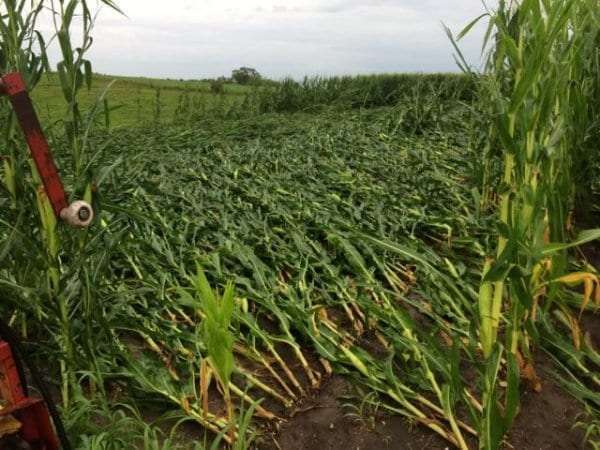Ag Informer – USDA to Pay for Crop Losses in 2020, 2021

The U.S. Department of Agriculture (USDA) today announced that commodity and specialty crop producers impacted by natural disaster events in 2020 and 2021 will soon begin receiving emergency relief payments totaling approximately $6 billion through the Farm Service Agency’s (FSA) new Emergency Relief Program (ERP) to offset crop yield and value losses.
“For over two years, farmers and ranchers across the country have been hard hit by an ongoing pandemic coupled with more frequent and catastrophic natural disasters,” said Agriculture Secretary Tom Vilsack. “As the agriculture industry deals with new challenges and stressors, we at USDA look for opportunities to inject financial support back into the rural economy through direct payments to producers who bear the brunt of circumstances beyond their control. These emergency relief payments will help offset the significant crop losses due to major weather events in 2020 and 2021 and help ensure farming operations are viable this crop year, into the next growing season and beyond.”
Background
On September 30, 2021, President Biden signed into law the Extending Government Funding and Delivering Emergency Assistance Act (P.L. 117-43), which includes $10 billion in assistance to agricultural producers impacted by wildfires, droughts, hurricanes, winter storms, and other eligible disasters experienced during calendar years 2020 and 2021. FSA recently made payments to ranchers impacted by drought and wildfire through the first phase of the Emergency Livestock Relief Program (ELRP). ERP is another relief component of the Act.
For impacted producers, existing Federal Crop Insurance or Noninsured Crop Disaster Assistance Program (NAP) data is the basis for calculating initial payments. USDA estimates that phase one ERP benefits will reach more than 220,000 producers who received indemnities for losses covered by federal crop insurance and more than 4,000 producers who obtained NAP coverage for 2020 and 2021 crop losses.
ERP Eligibility – Phase One
ERP covers losses to crops, trees, bushes, and vines due to a qualifying natural disaster event in calendar years 2020 and 2021. Eligible crops include all crops for which crop insurance or NAP coverage was available, except for crops intended for grazing. Qualifying natural disaster events include wildfires, hurricanes, floods, derechos, excessive heat, winter storms, freeze (including a polar vortex), smoke exposure, excessive moisture, qualifying drought, and related conditions.
For drought, ERP assistance is available if any area within the county in which the loss occurred was rated by the U.S. Drought Monitor as having a:
• D2 (severe drought) for eight consecutive weeks; or
• D3 (extreme drought) or higher level of drought intensity.
Lists of 2020 (PDF, 1.8 MB) and 2021 (PDF, 431 KB) drought counties eligible for ERP is available on the emergency relief website.
To streamline and simplify the delivery of ERP phase one benefits, FSA will send pre-filled application forms to producers where crop insurance and NAP data are already on file. This form includes eligibility requirements, outlines the application process and provides ERP payment calculations. Producers will receive a separate application form for each program year in which an eligible loss occurred. Receipt of a pre-filled application is not confirmation that a producer is eligible to receive an ERP phase one payment.
Additionally, producers must have the following forms on file with FSA within 60 days of the ERP phase one deadline, which will later be announced by FSA’s Deputy Administrator for Farm Programs:
• Form AD-2047, Customer Data Worksheet.
• Form CCC-902, Farm Operating Plan for an individual or legal entity.
• Form CCC-901, Member Information for Legal Entities (if applicable).
• Form FSA-510, Request for an Exception to the $125,000 Payment Limitation for Certain Programs (if applicable).
• Form CCC-860, Socially Disadvantaged, Limited Resource, Beginning and Veteran Farmer or Rancher Certification, if applicable, for the 2021 program year.
• A highly erodible land conservation (sometimes referred to as HELC) and wetland conservation certification (Form AD-1026 Highly Erodible Land Conservation (HELC) and Wetland Conservation (WC) Certification) for the ERP producer and applicable affiliates.
Most producers, especially those who have previously participated in FSA programs, will likely have these required forms on file. However, those who are uncertain or want to confirm the status of their forms can contact their local FSA county office.
ERP Payment Calculations – Phase One,/b>
For crops covered by crop insurance, the ERP phase one payment calculation for a crop and unit will depend on the type and level of coverage obtained by the producer. Each calculation will use an ERP factor based on the producer’s level of crop insurance or NAP coverage.
• Crop Insurance – the ERP factor is 75% to 95% depending on the level of coverage ranging from catastrophic to at least 80% coverage.
• NAP – the ERP factor is 75% to 95% depending on the level of coverage ranging from catastrophic to 65% coverage.
Full ERP payment calculation factor tables are available on the emergency relief website and in the program fact sheet (PDF, 813 KB).
Applying ERP factors ensures that payments to producers do not exceed available funding and that cumulative payments do not exceed 90% of losses for all producers as required by the Act.
Also, there will be certain payment calculation considerations for area plans under crop insurance policies.
The ERP payment percentage for historically underserved producers, including beginning, limited resource, socially disadvantaged, and veteran farmers and ranchers will be increased by 15% of the calculated payment for crops having insurance coverage or NAP.
To qualify for the higher payment percentage, eligible producers must have a CCC-860, Socially Disadvantaged, Limited Resource, Beginning and Veteran Farmer or Rancher Certification, form on file with FSA for the 2021 program year.
Because the amount of loss due to a qualifying disaster event in calendar years 202 and 2021 cannot be separated from the amount of loss caused by other eligible causes of loss as defined by the applicable crop insurance or NAP policy, the ERP phase one payment will be calculated based on the producer’s loss due to all eligible causes of loss.
Future Insurance Coverage Requirements
All producers who receive ERP phase one payments, including those receiving a payment based on crop, tree, bush, or vine insurance policies, are statutorily required to purchase crop insurance, or NAP coverage where crop insurance is not available, for the next two available crop years, as determined by the Secretary. Participants must obtain crop insurance or NAP, as may be applicable:
• At a coverage level equal to or greater than 60% for insurable crops; or
• At the catastrophic level or higher for NAP crops.
Coverage requirements will be determined from the date a producer receives an ERP payment and may vary depending on the timing and availability of crop insurance or NAP for a producer’s particular crops. The final crop year to purchase crop insurance or NAP coverage to meet the second year of coverage for this requirement is the 2026 crop year.
Emergency Relief – Phase Two (Crop and Livestock Producers)
Today’s announcement is only phase one of relief for commodity and specialty crop producers. Making the initial payments using existing safety net and risk management data will both speed implementation and further encourage participation in these permanent programs, such as Federal crop insurance, as Congress intended.
The second phase of both ERP and ELRP programs will fill gaps and cover producers who did not participate in or receive payments through the existing programs that are being leveraged for phase one implementation. When phase one payment processing is complete, the remaining funds will be used to cover gaps identified under phase two.
Through proactive communication and outreach, USDA will keep producers and stakeholders informed as program details are made available. More information on ERP can be found in the Notice of Funding Availability (PDF, 290 KB).
Additional Commodity Loss Assistance
The Milk Loss Program and On-Farm Stored Commodity Loss Program are also funded through the Extending Government Funding and Delivering Emergency Assistance Act and will be announced in a future rule in the Federal Register.




